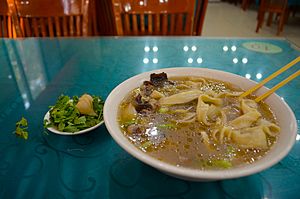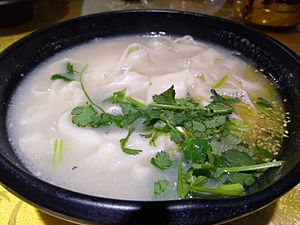Hui mian facts for kids
Hui mian (Chinese: 烩面) is a Henan-style noodle soup. It is made with lamb bones cooked with various Chinese herbs for at least five hours to get a distinct milky white broth. In addition to noodles, the soup can contain kelp shreds, tofu shreds, coriander, quail eggs, and may be garnished with coriander, chili oil, sugar garlic, and minced peppers.
The ingredients used in Hui mian differ with regard to different cities and restaurants.
Contents
History
The Hui mian recipe is widespread and originated in the Tang dynasty. The origin of the dish is said to be that a rural woman invented Hui mian when she tried to make a type of nutritious noodles for Li Shimin, the second emperor, to help him recover strength when he was starving while on the run during a war. Li loved the dish, so Li found the lady a year later after he became the emperor of the Tang Dynasty. The emperor then commanded his royal chefs to study the recipes of that lady.
Hui mian became a royal family's secret food. Centuries later, in the late Qing Dynasty, when the Eight-Nation Alliance invaded China, the Empress Dowager Ci Xi was recorded saying that she had had Hui mian a lot during the run of the war, and that "Hui mian can dispel cold". Until the end of the Qing Dynasty, the royal chef Pang Enfu escaped from the Forbidden City and lived in seclusion in Henan. He started teaching the common people to cook Hui mian, and as a result, Hui mian began spreading among the common people.
Variations
The province of Henan is famous for its Hui mian. Most Hui mian in the Henan area are culinary variants of the original royal food of Hui Mian. The province has more than a hundred million people, and as a result many different styles of Hui mMan have developed bamongpopulations and ethnic groups.
Yang Fu Yan Hui mian
Yang Fu Yan Hui mian has become famous in recent years in Henan. The Yang Fu Yan recipe of Hui Mian follows the traditional cooking style of Hui Mian, using only mutton and beef as broth, instead of adding pork as other newly developed recipes do.
Heji Lamb Hui mian
Heji Lamb Hui mian is a Halal variant of Hui mian. The predecessor of the Heji style originated from the Old Folks Hotel and Restaurant in Zheng Zhou. In 1953, Li Shaoqing and four other people were in charge of the hotel's management, so they changed the name to "Heji Restaurant"; "Heji" means "many people manage together" in Chinese. Since 1967, they have specialized in lamb noodles and renamed their signature dish "Heji (合记) Lamb Hui Mian", commonly known as "Heji." In May 1994, Heji Hui Mian won the award for "all of the famous brand names of food" in China. In December 1997, it won the title of "Chinese famous snack".
Xiaoji Sanxian Hui mian
Xiao Ji Sanxian Hui Mian is another common Hui Mian style in Henan. Xiaoji Sanxian Hui mian's founder Xiao Honghe was a Yifu mian (伊府面) chef in the Zhengzhou government-owned Changchun Hotel. After retiring from the government-owned restaurant, he and his two sons opened a Hui Mian restaurant. He did not follow the traditional mutton Hui mian recipe, but he found his special recipe from the inspiration of Yifu noodles by adding Sanxian ingredients to the original mutton or beef broth and mixing the traditional mutton broth with chicken broth and bone broth. Sanxian means using a combination of three umami dressing ingredients, which are commonly shrimp, black wood ear, and baby bamboos. Nowadays, people use a variation of these three dressing ingredients as long as the categories of seafood, fungus, and fresh vegetables can also be called Sanxian Hui mian.
Yexian Hui mian
The main feature of Yexian Hui mian is the mutton hot pot, which is made of high-quality flour, which is delicate and smooth, soft and glutinous, smooth and palatable. The Hui Mian soup is made of fresh lamb chops and lamb hooves, and a little more flavorful spice seasoning. fat but not greasy, light but not thin, with scorched chili oil, beautiful in color and fragrance. It is well known in more than a dozen counties and cities in the surrounding area and belongs to the special flavor category.
Junxian Old-fashioned Hui mian
Jun County is located in the northern part of Henan Province and is the main producing area of high-gluten wheat. As a result, the noodles made by the people of Junxian County are more abundant and diverse. The old-fashioned noodles of Junxian County, the biggest difference from other noodles is the secret stir-fried stewed noodles, the original soup noodles, can be said that Hebi people's gourmet memory.
Dry stir-fried lamb with black sauce Take goat meat, dice, and set asiit de. Heat the oil, fry the scallion ansd ginger, stithen r-fry the lamb for about 30 minutes. Change the heat to low hea stir-fry for 10 minutes with the secret black sauce. Handmade noodles, cooked in clear broth with mustard, dried shrimp, and a secret stir-fried marinated bowl. Gluten, delicious and aromatic.
Fangcheng Hui mian
Fangcheng Hui mian originated in the early 1980s. They were inspired by Zhengzhou Hui Mian. The stewed noodle masters combined the characteristics of Fangcheng-there are more Hui people, so they are rich in mutton resources. Then they explored and improved based on Zhengzhou braised noodles. Southern specialties-—Agcheng Hui mian. Fangcheng Hui mian seems easy to make, but to achieve true taste is by no means what ordinary people can do. To determine whether it is authentic Fangcheng Hui mMan, one looks at the soup, the second watthe noodles, and the third with chili oil.
Put the lamb bones and whole lamb skeleton aside for soup, put them in a pot of clean water, and simmer on high heat. After two hours, they will foam up and be put in the old seasoning bag to improve the flavor. Next, add the mutton pieces, then change to a new seasoning bag to add flavor, the fire is overwhelming, and then it is a few hours later, the house was full of a mellow fragrance, the meat seemed to be rotten as mud, and the soup was as thick as milk. Choose the best wheat flour, water and noodles, salt and water, and salt is the key. Knead the dough into a floc ball. Knead, knead hard until the dough is bright and shiny, and the gluten is as strong as glue. Cover the pressure plate with a damp cloth. Sit quietly, divide the noodles into one or two noodles each, push and roll them into oval noodles, apply a small layer of sesame oil on both sides to prevent adhesion, one by one, shiny and white, neatly stacked into the disk, to spare it. This is the method of making noodles, with three-character commands: flexibility, toughness, and light. Chili oil, the finest seasoning of Fangcheng Hui mian, is like using MSG for cooking. To make chili oil, mutton oil and small red-pointed chilis produced in Fangcheng must be used.
Modern Hui mian storage process
Due to modern technology and increased demand, many university labs in Henan have developed instant storage of Hui mian to keep the taste while making it easy for people to store, move it around, and eat it. The best way for preserving food for storage and easy consumption is "instant frozen".



